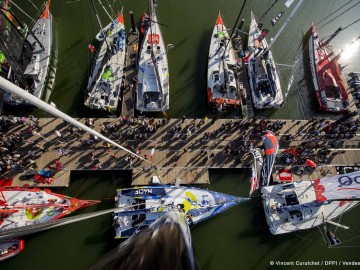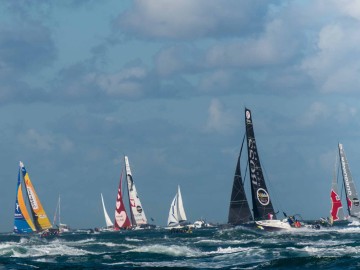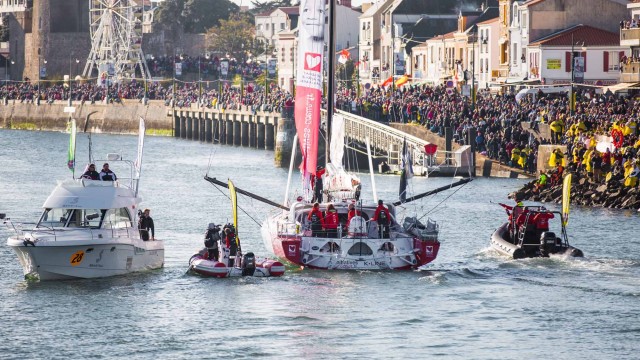Use this this alphabet to discover the big and small history of the Vendée Globe, a globally unique sailing race that starts and finishes in Sables-d'Olonne every four years. Participants take part solo, with no help or stop-offs.
A is for... Ambiance: at the time of the big start of the race and the return of the sailors, there is a festive atmosphere in the town of Sables-d'Olonne. Fans of sailing or simply anyone interested, from the four corners of France as well as foreign countries, gather at the port. Their aim is to get as close as they can to the brave knights of the ships and their imposing structures!
B is for... Boats: the 60-feet single-hull vessels on which participants set sail are real sea monsters fully equipped with all sorts of technology, which frequently reach a speed of 20 knots (37 km/h). The audience can see them by reach a pontoon located in the middle of the Vendée Globe Village, or even look around one of the ships and chat with their navigators!
C is for... Commencement: the great adventure of the Vendée Globe began with the 1989/1990 staging, at the end of which Titouan Lamazou won in 109 days, 8 hours and 48 minutes. He took the hero's parade up the Champs Elysées with his crewmate, Loïc Peyron.
D is for... Double-winner: the only sailor to have won the competition twice is Michel Desjoyeaux, winner of the 2000/2001 and 2008/2009 stagings.
E is for... Epic: the sailors complete a full world tour, the length of which is 21,638 miles (a little over 40,000 kilometres), just like the circumference of the Earth. Most participants nevertheless have to deal with multiple hazards, meaning they travel over 28,000 miles, or approximately 52,000 kilometres.
F is for... Females: the first two women to take part in the legendary course were Isabelle Autissier and Catherine Chabaud, in the 1996/1997 staging. Chabaud went on to become the first female sailor to complete a solo non-stop world circuit. A total of seven women have taken part in the competition, with Ellen MacArthur ranking the highest with second place in 2001/2002.


H is for... Hardy: Among the most astonishing stories is that of Bertrand Le Broc who, at the 1992/1993 Vendée Globe, had to stitch up his tongue – which had been severed by a rope – all alone, using a little pocket mirror. He then followed the instructions of a doctor onland by telex.
I is for... Incredible: the ultimate speed record is held by François Gabart, 2012/2013 winner with a total time of 78 days, 2 hours and 16 minutes. Only three hours separate him from the runner-up, Armel Le Cléac'h. It's unheard of! The two men were the first to break the legendary 80-day record.
O is for... One busy day: on 2004, Roland Jourdain achieved the feat of gobbling up 439 miles, or 800 kilometres, in just one day!
P is for... Participants: while the first staging, in 1989/1990, only brought together 13 competitors, the 2016/2017 event had three times that many.
R is for... Redoutable: the Vendée Globe is a massive challenge, to the extent that the proportion of sailors who managed to complete the course, before the 2016/2017 staging, was 71 in 138 – barely more than half!
S is for... Solidarity: During the 2008/2009 event, Jean Le Cam sank in Cape Horn and found himself in a critical situation. Vincent Riou therefore decided to leave the competition to help his friend out. Clinging to the hull, which sank further with every wave in the turbulent sea, Le Cam finally managed to grab the rigging thrown by his hero. The two men were symbolically ranked equal 3rd by the jury.
V is for... Village: open three weeks before the race, the Vendée Globe Village welcomes almost 1.5 million visitors during this period! It invites them to learn about the history of the competition and the world of the race in general, take part in events, discover the many treasures of the region and explore the stands of the hundreds of exhibitors.
Z is for... Zero help: during the more than two months that this non-stop race lasts for, sailors cannot receive any external help. This means they must forge their own incredible adventures, such as Yves Parlier during the 2000/2001 staging, who sailed under a jury-rig for many weeks after breaking his mast!



